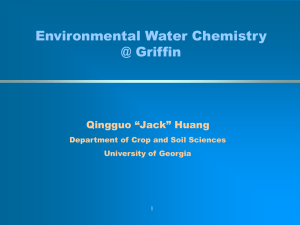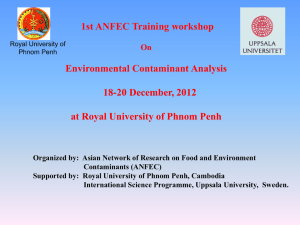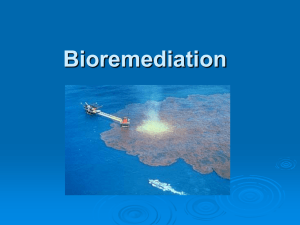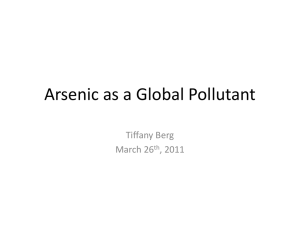BioThalis Proposal
advertisement
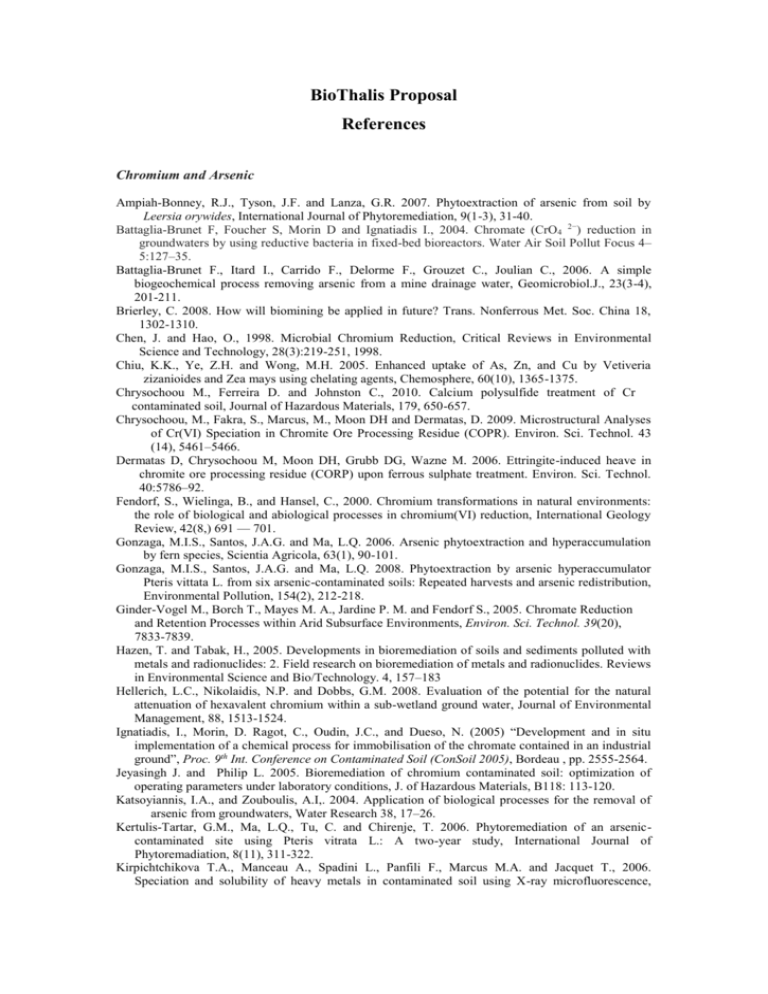
BioThalis Proposal References Chromium and Arsenic Ampiah-Bonney, R.J., Tyson, J.F. and Lanza, G.R. 2007. Phytoextraction of arsenic from soil by Leersia orywides, International Journal of Phytoremediation, 9(1-3), 31-40. Battaglia-Brunet F, Foucher S, Morin D and Ignatiadis I., 2004. Chromate (CrO4 2−) reduction in groundwaters by using reductive bacteria in fixed-bed bioreactors. Water Air Soil Pollut Focus 4– 5:127–35. Battaglia-Brunet F., Itard I., Carrido F., Delorme F., Grouzet C., Joulian C., 2006. A simple biogeochemical process removing arsenic from a mine drainage water, Geomicrobiol.J., 23(3-4), 201-211. Brierley, C. 2008. How will biomining be applied in future? Trans. Nonferrous Met. Soc. China 18, 1302-1310. Chen, J. and Hao, O., 1998. Microbial Chromium Reduction, Critical Reviews in Environmental Science and Technology, 28(3):219-251, 1998. Chiu, K.K., Ye, Z.H. and Wong, M.H. 2005. Enhanced uptake of As, Zn, and Cu by Vetiveria zizanioides and Zea mays using chelating agents, Chemosphere, 60(10), 1365-1375. Chrysochoou M., Ferreira D. and Johnston C., 2010. Calcium polysulfide treatment of Cr contaminated soil, Journal of Hazardous Materials, 179, 650-657. Chrysochoou, M., Fakra, S., Marcus, M., Moon DH and Dermatas, D. 2009. Microstructural Analyses of Cr(VI) Speciation in Chromite Ore Processing Residue (COPR). Environ. Sci. Technol. 43 (14), 5461–5466. Dermatas D, Chrysochoou M, Moon DH, Grubb DG, Wazne M. 2006. Ettringite-induced heave in chromite ore processing residue (CORP) upon ferrous sulphate treatment. Environ. Sci. Technol. 40:5786–92. Fendorf, S., Wielinga, B., and Hansel, C., 2000. Chromium transformations in natural environments: the role of biological and abiological processes in chromium(VI) reduction, International Geology Review, 42(8,) 691 — 701. Gonzaga, M.I.S., Santos, J.A.G. and Ma, L.Q. 2006. Arsenic phytoextraction and hyperaccumulation by fern species, Scientia Agricola, 63(1), 90-101. Gonzaga, M.I.S., Santos, J.A.G. and Ma, L.Q. 2008. Phytoextraction by arsenic hyperaccumulator Pteris vittata L. from six arsenic-contaminated soils: Repeated harvests and arsenic redistribution, Environmental Pollution, 154(2), 212-218. Ginder-Vogel M., Borch T., Mayes M. A., Jardine P. M. and Fendorf S., 2005. Chromate Reduction and Retention Processes within Arid Subsurface Environments, Environ. Sci. Technol. 39(20), 7833-7839. Hazen, T. and Tabak, H., 2005. Developments in bioremediation of soils and sediments polluted with metals and radionuclides: 2. Field research on bioremediation of metals and radionuclides. Reviews in Environmental Science and Bio/Technology. 4, 157–183 Hellerich, L.C., Nikolaidis, N.P. and Dobbs, G.M. 2008. Evaluation of the potential for the natural attenuation of hexavalent chromium within a sub-wetland ground water, Journal of Environmental Management, 88, 1513-1524. Ignatiadis, I., Morin, D. Ragot, C., Oudin, J.C., and Dueso, N. (2005) “Development and in situ implementation of a chemical process for immobilisation of the chromate contained in an industrial ground”, Proc. 9th Int. Conference on Contaminated Soil (ConSoil 2005), Bordeau , pp. 2555-2564. Jeyasingh J. and Philip L. 2005. Bioremediation of chromium contaminated soil: optimization of operating parameters under laboratory conditions, J. of Hazardous Materials, B118: 113-120. Katsoyiannis, I.A., and Zouboulis, A.I,. 2004. Application of biological processes for the removal of arsenic from groundwaters, Water Research 38, 17–26. Kertulis-Tartar, G.M., Ma, L.Q., Tu, C. and Chirenje, T. 2006. Phytoremediation of an arseniccontaminated site using Pteris vitrata L.: A two-year study, International Journal of Phytoremadiation, 8(11), 311-322. Kirpichtchikova T.A., Manceau A., Spadini L., Panfili F., Marcus M.A. and Jacquet T., 2006. Speciation and solubility of heavy metals in contaminated soil using X-ray microfluorescence, EXAFS spectroscopy, chemical extraction, and thermodynamic modeling, Geochim.Cosmochim. Acta 70( 9), 2163-2190. Kneebone PE, O'Day PA, Jones N, Hering JG, 2002. Deposition and fate of arsenic in iron- and arsenic enriched reservoir sediments. Env. Sci. Tech. 36, 381-386. Le Hecho, I., Tellier, S, and Astruc, M. 1998. Industrial soils contaminated with arsenic and chromium: evaluation of the elektrokinetic method. Environmental Technology, 19, 1095-1102. Loveley, D. and Coates, J. 1997. Bioremediation of metal contamination, Current Opinion in Biotechnology, 8, 285-289. Lovley, D. and Phillips E. (1994). “Reduction of chromate by Desulfovibrio vulgaris and its c3 cytochrome.” Appl. Environ. Microbiol., 60: 726-728. Ma, L.Q., Komar, K.M., Tu, C., Zhang, W., Cai, Y., Kennelley, E.D., 2001. A fern that hyperaccumulates arsenic. Nature 409, 579. MacDonald, L., Moon, H.S. and Jaffe, P. 2011. The role of biomass, electron shuttles, and ferrous iron in the kinetics of Geobacter sulfurreducens-mediated ferrihydrite reduction. Water Research, 45, 1049-1062. Manceau A., Marcus M.A. and Tamura N., 2002. Quantitative speciation of heavy metals in soils and sediments by synchrotron X-ray techniques. In Applications of Synchrotron Radiation in LowTemperature Geochemistry and Environmental Science, 49, 341–428. Michel C., Brugna M., Aubert C., Bernadac A. and Bruschi M. 2001. Enzymatic reduction of chromate: comparative studies using sulfate-reducing bacteria, Appl Microbiol. Biotechnol., 55: 95–100. Mohamed, A. 2002. Development of a novel electro-dialysis based technique for lead removal from silty clay polluted soil. Journal of Hazardous Materials B90 (2002) 297–310 Oremland et al. 2009. Arsenic in the Evolution of Earth and Extraterrestrial Ecosystems. Geomicrobiology Journal, 26:522–536 Oremland R., Hoeft S., Santini J., Bano N., Hollibauch R., Hollibauch J., 2002. Anaerobic oxidation of arsenite in Mono Lake water and by facultative, arsenite-oxidising chemoautotroph, strain MLHE-1, Appl.Envir.Microbiol., 2002, 68(10), 4795-4802. Ottosen, L.M., Hansen, H.K., Bech-Nielsen, G, Villumsen, A., 2000. Electrodialytic remediation of an arsenic and copper polluted soil - continuous addition of ammonia during the process. Environmental Technology, 21, 1421-1428. Otte, M.L., Rozema, J., Beek, M.A., Kater, B.J. and Broekman, R.A. 1990. Uptake of arsenic by estuarine plants and interactions with phosphate, in the field (Rhine estuary) and under outdoor experimental conditions, Science of the Total Environment, 97-98, 839-854. Papassiopi, N., Kontoyianni, A., Vaxevanidou, K. and Xenidis, A., 2008. Evaluation of Fe(III) reducing microorganisms for the biostabilisation of chromium in contaminated soils, Proceedings of International Conference GeoCongress 2008, New Orleans, Lousiana, USA, March 9-12, 2008, pp 535-542. Papassiopi, N., Kontoyianni, A., Vaxevanidou, K., and Xenidis, A., 2009. Assessment of chromium biostabilization in contaminated soils using standard leaching and sequential extraction techniques. Sci. Total Envir. 407, 925-936. Puls, R., Paul, C., Powell, R.., 1999. The application of in situ permeable reactive (zero-valent iron) barrier technology for the remediation of chromate-contaminated groundwater: a field test. Appl. Geochem., 14, 989-1000. Rama-Krishna K., Philip L., (2005), Bioremediation of Cr(VI) in contaminated soils, Journal of Hazardous Materials B121, pp.109-117 Rhine E., Garcia-Dominguez, E., Phelps, C. and Young L., 2005. Environmental microbes can speciate and cycle arsenic. Environmental Science and Technology 39, 9569-9573. Rhine, E.D., Phelps, C.D., Young, L.Y., 2006. Anaerobic arsenite oxidation by novel denitrifying isolates. Environ. Microbiol. 8 (5), 899–908. Sass, B.M. and Rai, D., 1987. Solubility of amorphous chromium (III) – iron(III) hydroxide solid solutions. Inorg. Chem., 26:2228-2232 Scheidegger A.M., Vespa M., Grolimund D., Wieland E., Harfouche M., Bonhoure I., and Dähn R., 2006. The use of (micro)-X-ray absorption spectroscopy in cement research, Waste Management 26(7), 699-705. Scheidegger, A., Borkovec, M., Sticher, H., 1993. Coating of silica sand with goethite: preparation and analytical identification. Geoderma 58, 43–65. Schwertmann, U., Cornell, R.M., 2000. Iron Oxides in the Laboratory, 2nd edition. Wiley-VCH Verlag, Weinheim. 188 pp. Stewart, D., Burke, I., Hughes-Berry, D., and Whittleston, R. 2010. Microbially mediated chromate reduction in soil contaminated by highly alkaline leachate from chromium containing waste. Ecological Engineering, 36(2) 211-221. Sun W., Sierra R., Field J., Anoxic oxidation of arsenite linked to denitrification in sludges and sediments, Water Research, 2008, 42(17), 4569-4577. Sun W., Sierra-Alvarez R., Fernandez N., Sanz J., Amils R., Legatzki A., Maier R., Field J., A molecular characterization and in situ quantification of anoxic arsenite-oxidising denitrifying enrichment cultures, FEMS Microbiol.Ecol., 2009, 68(1), 72-85. Tassi, E., Pedron, F., Barbafieri,, M. and Petruzzelli, G. 2004. Phosphate-assisted phytoextraction in As-contaminated soil, Engineering in Life Sciences, 4(4), 341-346. Tebo, B. M., and Obraztsova, A. Y., 1998. Sulfate-reducing bacterium grows with Cr(VI), U(VI), Mn(IV), Fe(III) as electron acceptors. FEMS Microbiol. Lett. 162, 193–198. Tseng, J.K. and Bielefeldt, A.R. (2002). “Low temperature chromium(VI) biotransformation in soil with varying electron acceptors”, J. Environ. Qual. 31: 1831–1841. Van der Zee, F.P. and Cervantes, F.J., 2009 Impact and application of electron shuttles on the redox (bio)transformation of contaminants: A review. Biotechnology Advances, 27, 256-277. Vaxevanidou, K., Christou, C. Papassiopi, N., and Georgakopoulos D. 2011b . Microbial mobilization of arsenic from a soil contaminated by wood-preservation activities. Unpublished data. Vaxevanidou, K., Giannikou, S. and Papassiopi N., 2011a. Investigation of indigenous arseno-reducing activity in soils with natural and artificial contamination. 4th Environmental Symposium of Macedonia, Thessaloniki, March 18-20, 2011 (in Greek). Vaxevanidou, Κ., Papassiopi, Ν. and Paspaliaris, Ι., 2008. Removal of heavy metals and arsenic from contaminated soils using bioremediation and chelant extraction techniques. Chemosphere, 70(8), 1329-1337. Verbruggen, N., Hermans, C and Schat, H. 2009. Mechanisms to cope with arsenic or cadmium excess in plants. Current opinion in plant biology, 12, 364–372 Viti, C. and Giovannetti, L., 2007. Bioremediation of Soils Polluted with Hexavalent Chromium using Bacteria: A Challenge. In Environmental Bioremediation Technologies, Singh, S. and Tripathi, R. Eds., Springer Berlin Heidelberg, 57-76 Wang Y-T. and Xiao C., (1995). “Factors affecting hexavalent chromium reduction in pure cultures of bacteria”, Water Research 29 (11) pp. 2467-2474 Wang, S and Zhao, X. 2009. On the potential of biological treatment for arsenic contaminated soils and groundwater. Journal of Environmental Management, 90, 2367–2376 Wielinga B., Mizuba M., Hansel C. and Fendorf S., (2001) “Iron promoted reduction of chromate by dissimilatory iron-reducing bacteria”, Environ. Sci. Technol., 35: 522-527. Yuan, C., Tzu-Shing Chiang, T-S., 2008. Enhancement of electrokinetic remediation of arsenic spiked soil by chemical reagents. Journal of Hazardous Materials, 152, 309–315. Organic contaminants Bradley, P.M., Chapelle, F.H., Wilson, J.T., 1998. Field and laboratory evidence for intrinsic biodegradation of vinyl chloride contamination in a Fe(III)-reducing aquifer. J. Contam. Hydrol., 31, 1-2, 111-127. Bradley, P.M., 2003. History and ecology of chloroethene biodegradation: a review. Bioremediation, 7, 2, 81–109. Brown, R.A., Mueller, J.G., Seech, A.G., Henderson, J.K., Wilson, J.T., 2009. Interactions between biological and abiotic pathways in the reduction of chlorinated solvents. Remediation, 20, 1, 9-20. Butler, E.C., Hayes, K.F., 2001. Factors influencing rates and products in the transformation of trichloroethylene by iron sulfide and iron metal. Environ. Sci. Technol., 35, 19, 3884-3891. Council Directive 98/83/EC of 3 November 1998 on the quality of water intended for human consumption. Dong, Y., Liang, X., Krumholz, L.R., Philp, R.P., Butler, E.C., 2009. The relative contributions of abiotic and microbial processes to the transformation of tetrachloroethene and trichloroethylene in anaerobic microcosms. Environ. Sci. Technol., 43, 3, 690-697. El Mamouni, R., Jacquet, R., Gerin, P., Agathos, S.N., 2002. Influence of electron donors and acceptors on the bioremediation of soil contaminated with trichloroethene. Water Sci. and Technol., 45, 10, 49–54. Hendrickson, E.R., Payne, J.A., Young, R.M., Starr, M.G., Perry, M.P., Fahnestock, S., Ellis, D.E., Ebersole, R.C., 2002. Molecular analysis of Dehalococcoides 16S ribosomal DNA from chloroethene-contaminated sites throughout North America and Europe. Appl. Environ. Microbiol. 68, 2, 485-495. Hoelen, T.P., Reinhard, M., 2004. Complete biological dehalogenation of chlorinated ethylenes in sulfate containing groundwater, Biodegradation 15, 6, 395–403. Kennedy, L.G., Everett, J.W, Becvar, E., DeFeo, D., 2006. Field-scale demonstration of induced biogeochemical reductive dechlorination at Dover Air Force Base, Dover, Delaware. J. Contam. Hydrol., 88, 1-2, 119-136. Lee, P.K.H., Macbeth, T.W., Sorenson, K.S. Jr., Deeb, R.A., Alvarez-Cohen, L., 2008. Quantifying genes and transcripts to assess the in situ physiology of “Dehalococcoides” spp. in a trichloroethene-contaminated groundwater site. Applied and Environmental Microbiology, 74, 9, 2728-2739. Lee, W., Batchelor, B., 2002. Abiotic reductive dechlorination of chlorinated ethylenes by iron-bearing soil minerals. 1. Pyrite and Magnetite. Environ. Sci. Technol. 36, 23, 5147-5154. Lovley, D.R., 2001. Anaerobes to the rescue. Science 293, 5534, 1444-1446. Maymó-Gatell, X., Chien, Y.T., Gossett, J.M., Zinder, S.H., 1997. Isolation of a bacterium that reductively dechlorinates tetrachloroethene to ethene. Science 276, 5318, 1568-1571. McGuire, T.M., Newell, C.J., Looney, B.B., Vangelas, K.M., 2004. Historical and retrospective survey of monitored natural attenuation: A line of inquiry supporting monitored natural attenuation and enhanced passive remediation of chlorinated solvents. U.S. Department of Energy, Office of Scientific and Technical Information, Oak Ridge, Tennessee. Mora R.H., Macbeth, T.W., MacHarg, T., Gundarlahalli, J., Holbrook, H., Schiff, P., 2008. Enhanced bioremediation using whey powder for a trichloroethene plume in a high sulfate, fractured granitic aquifer. Remediation, 18, 3, 7-30. Morse, J.J., Alleman, B.C., Gossett, J.M., Zinder, S.H., Fennell, D.E., Sewell, G.W., Vogel, C.M., 1998. A treatability test for evaluating the potential applicability of the reductive anaerobic biological in situ treatment technology (RABITT) to remediate chloroethenes. ESTCP, Arlington, Virginia. Panagiotakis, I., Mamais, D., Pantazidou, M., Marneri, M., Parapouli, M., Hatziloukas, E., Tandoi, V., 2007. Dechlorinating ability of TCE-fed microcosms with different electron donors. J. Hazardous Materials, 149, 3, 582-589. Panagiotakis, I., 2010. The effect of electron donor and sulfate on in situ bioremediation of chloroethene-contaminated aquifers. PhD thesis, National Technical University of Athens (in Greek). Pantazidou, M., Panagiotakis, I., Mamais, D., Zikidi, V., 2011. Chloroethene biotransformation in the presence of varying sulfate concentrations, Submitted for review to Groundwater Monitoring and Remediation (February 2011). Peale, J.G.D., Mueller, J., Molin, J., 2010. Successful ISCR-enhanced bioremediation of a TCE DNAPL source utilizing EHC® and KB-1®. Remediation, 20, 3, 63–81. Rossetti, S., Aulenta, F., Majone, F., Crocetti, G., Tandoi, V., 2008. Structural analysis and performance of a microbial community from a contaminated aquifer involved in the complete reductive dechlorination of 1,1,2,2-tetrachloroethane to ethene. Biotechnology and Bioengineering, 100, 2, 240-249. Shen, H., Wilson, J.T., 2007. Trichloroethylene removal from groundwater in flow-through columns simulating a permeable reactive barrier constructed with plant mulch. Environ. Sci. Technol., 41, 11, 4077-4083. Shetty, N., Zenker, M., McKeon, J., Moreno, J., 2009. Remediation of chlorinated ethenes, ethanes, methanes in groundwater using carbon- and iron-based electron donor, Remediation, 19, 4, 35-48. Stiber, N.A., Pantazidou, M., Small, M.J., 1999. An expert system methodology for evaluating reductive dechlorination at TCE sites. Environ. Sci. Technol., 33, 17, 3012-3020. Xenidis, A., Bartzas, G., Papassiopi, N., Andreou, A., Tsakiridis P., 2010. Removal of aqueous Cr(VI) ions using nanoscale zero-valent iron particles, 2nd Int. Symp. on Green Chemistry for Environment and Health, Mykonos, Sept. 27-29. Xiu, Z., Jin, Z., Li, T., Mahendra, S., Lowry, G.V., Alvarez, P.J.J., 2010. Effects of nano-scale zerovalent iron particles on a mixed culture dechlorinating trichloroethylene. Bioresource Technol., 10, 4, 1141-1146. Zikidi, V.M., 2010. Comparative presentation and analysis of field scale applications of bioremediation through anaerobic reductive dechlorination. Diploma thesis, National Technical University of Athens (in Greek). Microbiological techniques Karr, E.A., Sattley, W.M., Rice, M.R., Jung, D.O., Madigan, M.T., Achenbach, L.A. 2005. Diversity and distribution of sulfate-reducing bacteria in permanently frozen Lake Fryxell, McMurdo Dry Valleys, Antarctica. Applied and Environmental Microbiology, 71 (10), pp. 6353-6359 Lovley, D., 2003. Cleaning with genomics: applying molecular biology to bioremediation, Nature Reviews/Microbiology, 1, 35-44. Lücker, S., Steger D., Kjeldsen K.U., MacGregor B.J., Wagner M., Loy A. 2007. Improved 16S rRNATargeted Probe Set for Analysis of Sulfate-Reducing Bacteria by Fluorescence In Situ Hybridization. Journal of Microbiological Methods, 69, 523-528. Malik, S, Beer, M., Megharaj, M. and Naidu, R. 2008. The use of molecular techniques to characterize the microbial communities in contaminated soil and water. Environment International 24, 265276. Marneri M., Mamais D., Koutsiouki E. (2009). Microthrix parvicella and Gordona amarae in mesophilic and thermophilic anaerobic digestion systems. Environmental Technology, 30 (5), 437 – 444. Penhaler A., Pernhaler J., 2005. Simultaneous Fluorescence In Situ Hybridization of mRNA and rRNA for the Detection of Gene Expression in Environmental Microbes. Methods in Enzymology, 397, 352 – 371. Rossetti, S., Aulenta F., Majone M., Crocetti G., Tandoi V., 2008. Structure Analysis and Performance of a Microbial Community from a Contaminated Aquifer Involved in the Complete Reductive Dechlorination of 1,1,2,2-Tetrachloroethane to Ethene. Biotechnology and Bioengineering, 100, 240-249. Weldon, J. M., MacRae, J.D. 2006. Correlations between arsenic in Maine groundwater and microbial populations as determined by fluorescence in situ hybridization, Chemosphere, 63, 440 – 448.
